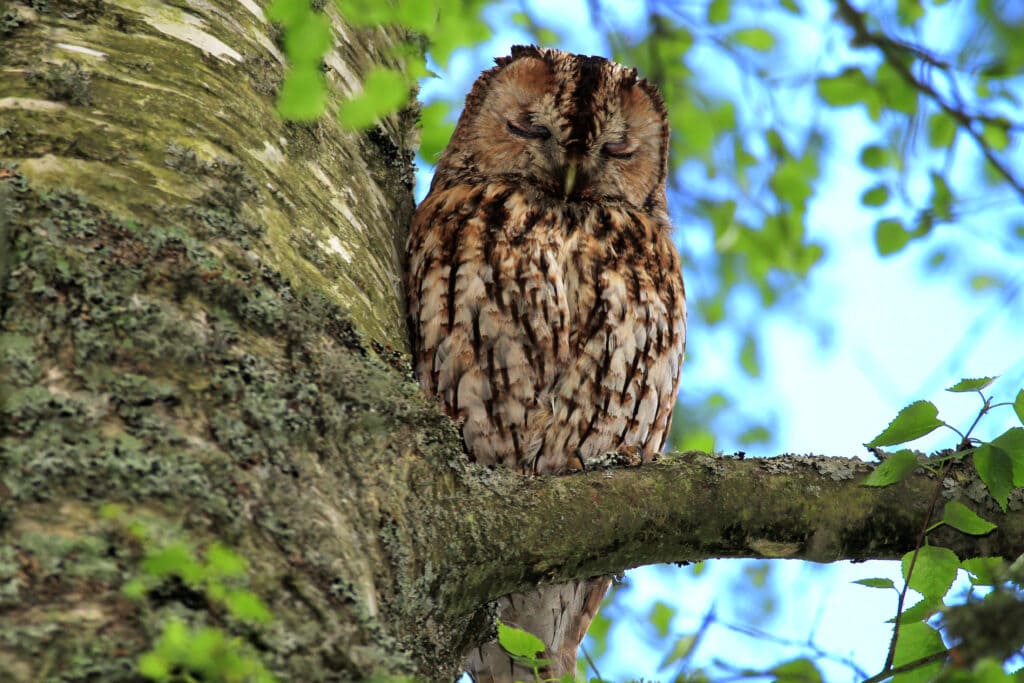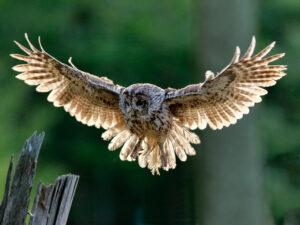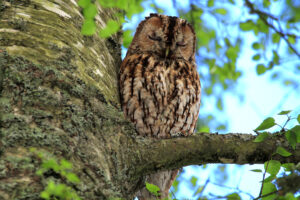Get To Know: The Tawny Owl
Tawny Owls are robust owls with a round body and head. They typically have reddish-brown feathers along their back with paler-colored feathers underneath. You can recognize them by the ring of dark feathers that frame their face and surrounding their dark eyes. Tawny Owls are usually found in their resident territories in established breeding pairs.
Key Facts
Scientific Name: Strix Aluco
Bird Family: Typical Owls Strigidae
Diet: Small mammals and rodents, small birds, frogs, fish, insects, and worms
Population: Global population 2 million/ UK Breeding: 50,000
Measurements: Length: 37-39 cm/ Wingspan: 94-104 cm /Weight: 330-590 g
Conservation Status and Threats
Tawny owls are on the amber list for UK birds. This means that their conservation status is of moderate concern. They were placed on the amber list due to concerns about long-term population decline.
Tawny Owls are vulnerable to many of the same issues that impact bird species, including habitat loss and abundance of prey.
Nesting and Breeding Habits
Tawny Owls live in established breeding pairs and choose nesting sites in the autumn. The males court the females for several weeks before mating, often displaying by swaying. Tawny Owls commonly nest in deciduous trees or nestboxes. They lay their eggs around March and have an incubation period of around a month. Young Tawny Owls are fed by both parents for two or three months.
When and Where to See Them
The Tawny Owl is nocturnal and is often heard, but not seen. You might catch a glimpse of a Tawny Owl during the day if you inadvertently disturb one from its roost site. Keep an eye out for owl pellets on the ground that could hint at roosting site above. You can find Tawny Owl year-round across England, Wales, and Scotland. Visit the Chapel Wood RSPB reserve in southwestern England for your chance to see a Tawny Owl.
How You Can Help
You can help the Tawny Owl thrive by using recycling programs that can decrease pollution and by supporting the RSPB.
Volunteer: RSPB Volunteering Program
Donate: RSPB Donation Page
About The Artist
Mark has been a freelance artist for around 10 years. He started in the punk rock scene in London, creating artwork for my friend’s bands. He spent his evenings drawing sharks and skulls (and more dinosaurs.) He started entering a few competitions for movie posters and from there progressed to officially licensed pieces with various galleries.
Website: markbellillustration.com
About Our Partner
The RSPB is the UK’s largest nature conservation charity, working locally in the UK, and around the world. Our vision is a shared world where wildlife, wild places, and all people thrive. We act by protecting and restoring habitats, saving species, and helping to end the nature and climate emergency. Nature is in crisis. Together we can save it.
For all licensed Products sold by Historiart, Historiart will donate a minimum of £10,000 per annum to RSPB Sales Ltd, which gives all its distributable profits through Gift Aid to the RSPB.
Manufactured under license from RSPB Sales Limited to raise awareness of the RSPB (charity registration in England and Wales no 207076 and Scotland no SC037654).





